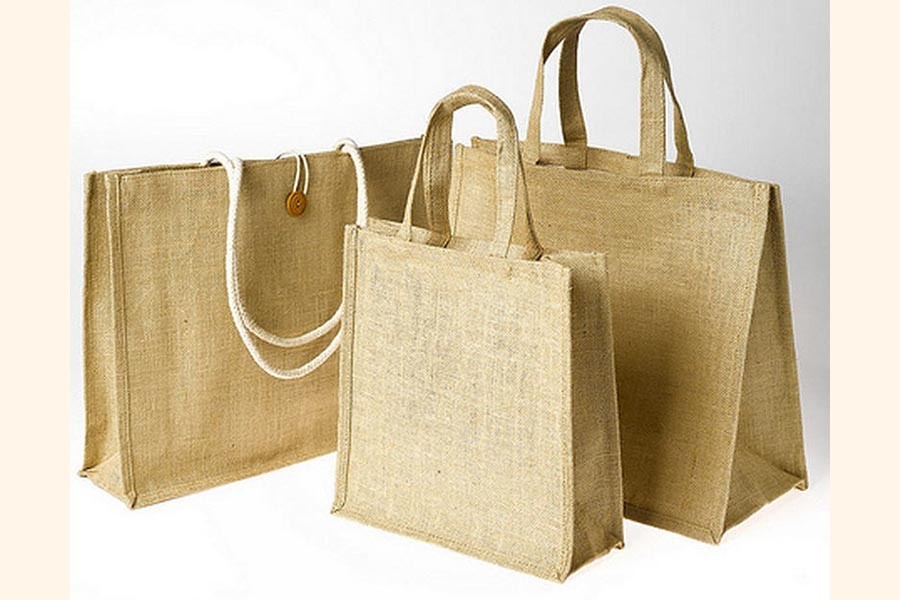One has to agree with Prime minister Sheikh Hasina that with pollution threatening the global environment, there is a huge potential for the environment-friendly jute-made goods now being produced in the country. On the occasion of the World Environment Day last week, the Prime Minister rightly emphasised on the diversified use of jute and discouraged the use of plastic products.
Meantime, our scientists have already invented a jute-made biodegradable poly bag called 'Sonali Bag' which is environment-friendly. The mills under Bangladesh Jute Mills Corporation (BJMC) are producing Sonali Bag as a substitute for the polythene bag. Fashionable bags are also now produced from jute.
The government has declared the jute and jute goods as agro-based products recently. This will enable the sector to avail all the benefits the country's other agro-based items get. Currently, agro-based products are getting 20 per cent cash incentives on their exports.
The fate of millions of farmers and workers depends on the jute sector. The government has decided to formulate an independent policy to revive the glory of the country's 'golden fibre', further expand its market at home and abroad and also promote its diversified use.
With the closure of Adamjee and other jute mills, tragedy fell on the jute growers and traders as there were no buyers in the country, opening the flood gates for smuggling of raw jute to India. And the situation had miserably worsened when the largest jute producer in the region produced just only 0.1 million tonnes of jute per year, while India was producing annually over two million tonnes of raw jute. Such a miserable condition continued for a long time.
The Indian Ministry of Finance recently slapped anti-dumping duty (ADD) ranging from US$19 to $351.72 per tonne on import of jute goods from Bangladesh for five years. The products, subjected to the ADD, are jute yarn, twine, hessian fabrics and jute sacking bags.
India alleged that Bangladesh was exporting jute sacking cloths to avoid or circumvent the anti-dumping duty imposed on jute sacking bags. The country's earnings from export of jute goods have declined significantly following imposition of the Indian anti-dumping duty.
Despite dipping export trend in the international market, jute (including jute goods) is still the second largest export product next to ready-made garments, and currently Bangladesh is the second largest exporter of jute after India.
Though export of jute goods is increasing, a significant quantity of export comprises traditional items like hessian, sacking, raw jute and jute yarn which notably add less value. High value added jute goods have huge potential as diversified jute products can add value 10 times more than the traditional one.
According to a recent research conducted by the Jute Diversification Promotion Centre (JDPC), there are 133 diversified jute products and approximately 400 DJP producers in Bangladesh which are mainly operating on sub-contract basis for export market.
DJP producers make a wide array of products including shopping bags, hand bags, wine bags, handicrafts, rags and conference bags. Relatively new inclusions are espadrilles, fashion clothing, jewelleries etc. Despite growing demand for new product range, the largest export segment includes different types of jute bags.
The demand for new types of diversified jute products like gardening products, shopping bags, geo-textile, pulp and paper, home textiles, household products, floor covering and non-woven textiles is very high at the consumers' level in the international market due to fast changing consumer behaviour.
Bangladesh has no proper preparation for tapping the market as there is no adequate infrastructure. High-tech jute goods have tremendous demand across the globe. Machineries of jute mills in Bangladesh are 50 years old and most of the plants have no facilities of dyeing and lamination which are essential for producing diversified products.
In order to seize international market opportunities for jute goods, a technical institute for developing skilled human resources in this sector needs to be set up. Professional design institute with R&D (research and development) facilities for product development is also crucial.
Diversified jute products can find a huge market at home and abroad in the wake of growing concern for the environment across the world. Admiration for jute products has increased remarkably in recent time across the world as the products made of synthetic fibre result in environmental hazard.
Tremendous demand for jute products has been noticed in the USA as they are environment friendly. But, success of jute and jute products largely depends on making use of the worldwide awareness of the environment. Moreover, the producers have to enhance quality and ensure durability of diversified jute products to survive in the competitive market.
Through a joint initiative of entrepreneurs, the Export Promotion Bureau, commerce ministry and foreign missions can create a huge market of the diversified jute products. New initiatives should open up great prospects for diversified use of jute and export, if patronised.
Innovation and diversified use of jute at local and international markets have opened up a new opportunity for jute to stage a come-back. The government should provide necessary incentives to the sector for its new branding and global dominance.
The matters relating to jute sector, under the circumstances, should be properly looked into on a priority basis, for implementation of the required policy-support. This sector did not receive a befitting attention from all the past governments. It is time that jute industry got concentrated focus.


